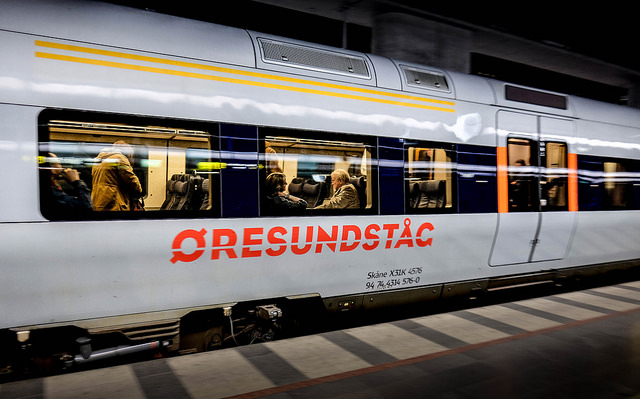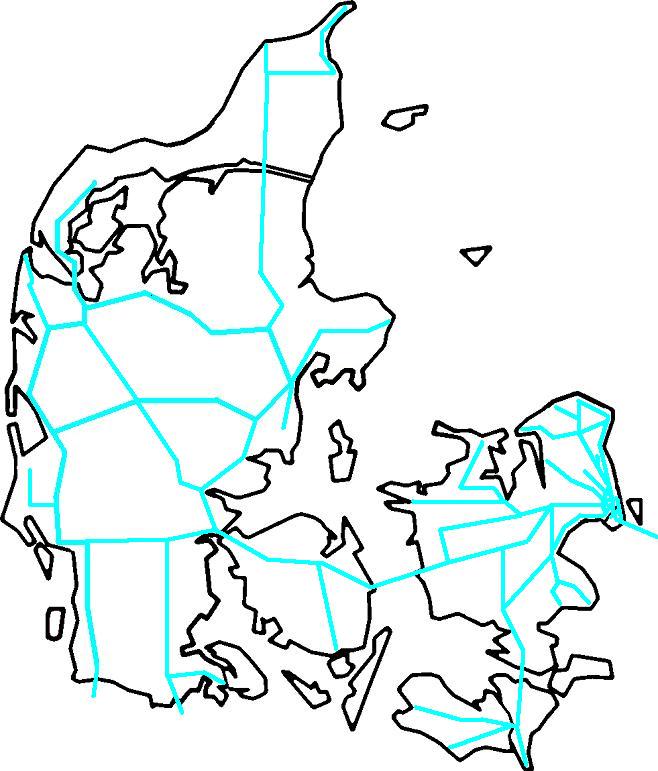Getting to Denmark
Flying
If you are arriving by air, you will most likely land at Copenhagen airport Kastrup (CPH). This airport is flying in excess of 20-million passengers per year to both distant (European and Intercontinental) and domestic destinations. Copenhagen Airport has a rail terminal for transport to the city and buses run frequently. Taxis are plentiful but more expensive; fares include VAT and tips, and you can normally pay by credit card.
 Other smaller airports are mainly used by short-haul airliners:
Other smaller airports are mainly used by short-haul airliners:
-
Aarhus Airport Tristrup (AAR) is the second International airport, located in northeast Jutland and situated a fair distance from the city of Aarhus. The airport operates flights to both domestic and European destinations, with about 100 destinations served in total. The airport is only open in the daytime and transport to the city is by bus.
-
Billund Airport (BLL) is situated about 120 km south of Aarhus and has regular flights to most European countries. When arriving at Billund, the obvious choice would be to take the airport bus to Aarhus.
-
Bornholm Airport (RNN) is situated very close to the island's capital Ronne. Regular flights are operated from Copenhagen Airport.
-
Also check the information for taking your bike on the plane
By train to Denmark
 There are direct regular international trains from Germany and Sweden:
There are direct regular international trains from Germany and Sweden:
-
Germany - The “Vogelfluglinie” starts in Copenhagen and uses a train ferry from Rødby in Denmark to Puttgarden in Germany. This train then proceeds via Lübeck to Hamburg;
-
Sweden - The SJ-line connects Copenhagen to Malmö in Sweden using the Oresund Railway across the 10 km (6 mi) long Oresund bridge-tunnel combination.
Ferries to Denmark
 Being almost an island Denmark has an extensive network of international ferry services:
Being almost an island Denmark has an extensive network of international ferry services:
-
Color Line
Hirtshals - Kristiansand, Norway
Hirtshals - Larvik, Norway -
DFDS Seaways
Copenhagen - Oslo, Norway -
Fjord Line
Hirtshals - Bergen, Norway
Hirtshals - Stavanger, Norway -
Scandlines
Hensigør - Helsingborg, Sweden
Rødby - Puttgarden, Germany
Gedser - Rostock, Germany -
Smyril Line
Hantsholm - Seydisfjördur, Iceland
Hantsholm - Torshaven, Faroer -
Stena Line
Fredrikshaven - Oslo, Norway
Fredrikshaven - Göteborg, Sweden
Grenaa - Varberg, Sweden
To Denmark by bus
Denmark has bus connections provided by Eurolines to many European countries. Abildkskou-Busser and Grahundbus also operate regular bus services to Berlin in Germany and Malmö in Sweden. Not all lines run on a daily basis.
To Denmark by car
 Denmark can be reached from Germany and Sweden via a superb network of motorways and roads. Cars can be stopped at the border for random checks, but this happens very rarely. An International Driving Permit is not required for up to 180 days with tourist or visitor status, as long as you are in the possession of a driving license from your country of origin.
Denmark can be reached from Germany and Sweden via a superb network of motorways and roads. Cars can be stopped at the border for random checks, but this happens very rarely. An International Driving Permit is not required for up to 180 days with tourist or visitor status, as long as you are in the possession of a driving license from your country of origin.
European "E" roads are international motorways linking Denmark to the rest of Europe. E-road signs are always green with white numbers. In Denmark there are five European motorways (called 'Motorvej'): the E20, E39, E45, E47 and E55. Each motorway exit has both a number and a name (most often the name of the nearest town). A hexagonal sign with a white background and red numbers indicates the number of the exit. A blue road sign indicate the name(s) of the exit.
-
Also check road signs in Denmark.
Getting around in Denmark
Trains in Denmark
 Denmark has an extensive, efficient and affordable public transport system, partly run by the state and partly by private companies. The Danish State Railways Service, the DSB [‘Danske Statsbaner’] provides services on 80% of the routes. The other 20%, predominantly in the mid-west are operated by Arriva and are called "Privatbane". There are two main types of trains: The InterCity Express [Lyntogs] trains and local trains [Regionaltog'] which stop at every station.
Denmark has an extensive, efficient and affordable public transport system, partly run by the state and partly by private companies. The Danish State Railways Service, the DSB [‘Danske Statsbaner’] provides services on 80% of the routes. The other 20%, predominantly in the mid-west are operated by Arriva and are called "Privatbane". There are two main types of trains: The InterCity Express [Lyntogs] trains and local trains [Regionaltog'] which stop at every station.
Both express and local trains run at least one-hourly service on the principle routes. With the exception of a few rural lines, the minimum weekday frequency is one train every 30 minutes.Tickets are available at all stations, both DSB and private, and there is one national tariff system. Ticket reservation is strongly advised. Combining the rail and bus services is also very simple, as your train ticket extends to your continued journey on a bus. The Express trains have 2 categories: Business (former 1st-class) and Standard" (former 2nd-class). It is perfectly feasible to take your bikes on the majority of Danish trains. You will need to purchase a separate ticket for your cycle from the ticket office. The Scandinavian Rail Pass allows unlimited travel within Denmark, Finland, Norway and Sweden.
-
Visitors planning to travel by train more frequently or who intend to travel longer distances should consider one of the discount offers, such as the “Eurail / Interrail” pass.
Ferries in Denmark

Buses in Denmark
The Danish coach and bus networks are extraordinarily extensive, and enable you to reach even the most remote corners of the country. To get from one end of the country to the other it is often quicker to hop on a coach than take the train, because the connection is usually more direct. Some cross-country bus routes work out to about 20% cheaper than trains. Daily express buses include connections between Copenhagen and Aarhus (3 hours) and between Copenhagen and Aalborg (5 hours). There’s also a twice a day express-bus service between the Jutland port cities of Frederikshavn and Esbjerg (five hours).
Urban bus services are also well organized. The Copenhagen Metro has become very popular with both local commuters and tourists since opening in 2002. A new metro-line connects Kastrup international airport with the city centre.
Transporting bikes on Danish buses is possible on some regional bus lines.
Travelling by car in Denmark
Denmark is a pleasant country for touring by car. Danish secondary roads are among the best in the world an all roads are good and very well signposted. Falck and DAH provides 7x24 hour emergency breakdown assistance.
Access to and from Danish motorways is straightforward - roads leading out of town centres are named after the main city that they lead to (e.g. the road heading out of Odense to Faaborg is called Faaborgvej). Today all main roads in Denmark have their own numbers, and all motorway exits are numbered as well. The colour of the road number indicates the road class and the route reference signs with their dotted frames refer to the roads further ahead. Denmark’s extensive ferry network carries motor vehicles at quite reasonable rates. Fares for cars average three times the passenger rate. It is always advised for drivers to make ferry reservations in advance (even if it is only a couple of hours ahead of time). Tolls are applicable for two main bridges in Denmark: the 18km (11mi) long toll Great Belt bridge and tunnel, linking Copenhagen with the island of Funen and the Oresund bridge-tunnel combination, which links Copenhagen with Malmö in Sweden.
-
Also check road signs in Denmark.
Taxis in Denmark
There are taxis available in all cities and most towns in Denmark, and drivers usually speak English. A vacant taxi carries the sign 'Fri' (free) in the window and a green light on top of the car. You can hail a taxi off the street or pick one up at the many taxi stands.
Taxi fares are relatively high. Tipping is not needed because a service charge is included in the fare.

